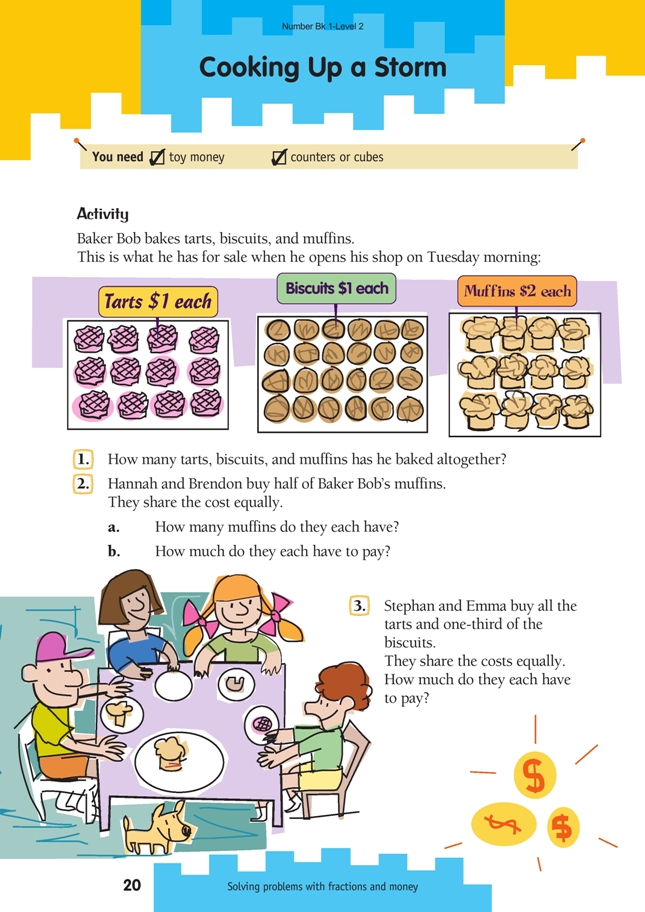This is a level 2 number activity from the Figure It Out series. It relates to Stage 5 of the Number Framework.
A PDF of the student activity is included.
Click on the image to enlarge it. Click again to close. Download PDF (134 KB)
solve problems involving fractions and money
FIO, Level 2, Number, Book 1, Cooking Up a Storm, page 20
counters or cubes
Encourage the students to use strategies other than counting from one to answer question 1. You could ask, “What’s the quickest way to work this out?” The students might use repeated addition to find the number of biscuits. This could be modelled with multilink cubes as either:
4 + 4 + 4 + 4 + 4 + 4
(which can be thought of as 4 and 4 is 8, and 4 is 12, and 4 is 16, and 4 is 20, and 4 is 24 biscuits altogether or as skip-counting by 4)
or:
6 + 6 + 6 + 6
(which can be thought of as 6 and 6 is 12, 12 and 6 makes 18, 18 and 6 more makes 24 biscuits altogether).
The students might also use their doubles to add the groups:
Double 4 is 8, 8 doubled is 16, plus another double 4 is 24,
or:
Double 6 is 12, and double 12 is 24.
Yet another possibility is that the students will see how many muffins or biscuits are on one half of a tray and double this number to find the total.
There is an opportunity here to link repeated addition to the conventional notation for
multiplication. Explain to the students that when they are adding lots of groups of the same number, there is a quicker way to record this and to talk about it. In the case of 4 + 4 + 4 + 4 + 4 + 4, there are six lots of 4, and six times 4 is recorded as 6 x 4.
Question 2 is about halving and doubling and will build on the students’ existing knowledge of halving and doubling numbers to 20. First, the students need to find half of 12 (the total number of muffins). To work out how many muffins they each have, they must halve 6. Finally, to find the cost to each child, they can either count in twos or double 3 to reach a cost of $6 each. The students who have recall of their doubles should be able to do this mentally. For those who are unsure, use the multilink cubes to represent muffins. You could set the toy money out in lots of $2
next to each muffin to help them work out the cost.
In order to find one-third of the biscuits in question 3, the students could use the multilink cubes and share the total of 24 biscuits into three equal groups. The answer of eight biscuits needs to be added to 12 tarts, giving 20 items altogether (which cost $1 each). The students could then work out the total cost before halving this figure to solve the problem.
The students might begin to find the cost in question 3 by using a similar approach to that in question 2. This would mean putting $1 next to each imaginary biscuit or tart. You should encourage the students to predict the cost by asking them “If one tart (or biscuit) costs $1 and two tarts (or biscuits) cost $2, how much will three tarts (or biscuits) cost? What about 20?” This can be connected to the one times table, which leaves the other number unchanged. The number 1 is known as the identity element for multiplication (and division) because when any number is multiplied by 1, it does not change.
You could extend this activity by asking questions such as:
“At the end of the day, Baker Bob reduces the cost of the biscuits to 50 cents each. Jack buys the remaining half of the biscuits. How much does he pay?”
Answers to Activity
1. 48 muffins, biscuits, and tarts altogether
2. a. 3 muffins
b. 3 x $2 = $6
3. $10
